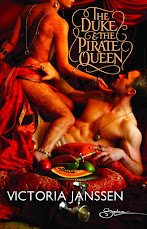
This post originated as a guest post for Lust in Time in December, 2008.
When I sold The Duchess, Her Maid, The Groom and Their Lover, the contract was for two books. I'd submitted several brief ideas for the second book, but didn't think about it too much until after I turned in the duchess manuscript. All I'd decided was that the story would be set during World War One (a research interest of mine, so I already had a library), and that it would have werewolves. I actually had the beginnings of a werewolf novel set during WWI, but after pondering for a few weeks, I realized that story would not work as an erotic novel. It was entirely too grim.
World War One is not the first setting one thinks of for an erotic romp; a dark, serious novel, yes, but I didn't want to write that kind of book; I wanted something fun, or at least mostly fun. So I came up with the idea of melding pulp adventure novels with the early days of World War One. In a pulp adventure novel, werewolves wouldn't be strange at all, and rather than make the war itself a villain, the force opposing the characters could be a classically cruel and amoral scientist. Overall, I wanted to work in two themes: differences between appearances and reality in relation to self, and technological warfare and a changing world affecting creatures of nature. My original title was Other Skins, to reflect those themes. Though I considered Sweet Savage Werewolves, too. *heh*
I would be writing something along the lines of the Doc Savage pulp stories, only set in an earlier period (interestingly, the characters in that series had backstory that they'd fought in WWI). I began to think about the characters, initially, in terms of their roles. To help my thought process, I polled my friends on which types of characters I should include. All of the characters in what eventually was titled Moonlight Mistress began as types, such as "a world-weary nurse who might shoot someone if they interfered with her patients" or "a cranky French soldier who is an expert in something useful." Once I'd narrowed down the most popular of the types I'd brainstormed, I then polled again, on possible pairings. The answers I received were different, in some cases, than the choices I'd made myself, but after some thought, I realized in those cases my friends were smarter than I was. Also, the whole process of polling was a lot of fun, for
both me and my friends, and got my tired brain started working on the new story. Once I had the types, I gave the characters names, and began to figure out who they were by writing scenes. I didn't complete a synopsis of the book, to turn in to my editor, until I had a significant amount of draft completed. Unlike the duchess novel, I never completed an outline, though I did make a list of scenes I wanted to write or felt I needed.
For a historical novel, the research is the best part, because mostly it involves reading. I searched out various bits of data online, but for the most part I read books, or read the parts of books that I needed. However, I didn't have time to do all the reading before I began writing. And no matter how much I knew before I began writing, I would definitely need to research more things as I went along and saw what the story needed.
The best research tool I had was a sheet of tiny stickies, which I used to mark pages in books that held useful information. This saved me from having to spend time making notes, and I could read whenever I was unable to write (for example, while riding the bus). The second best tool I discovered was keeping a list of research questions, as they came up. I wouldn't stop my writing session for research on these tiny items; I would make a note and go on, and later look up several answers at once. Examples of these questions are "list of period Anglican choral composers" and "car available with self-starter in 1914?" and "area of chemical study appropriate for time period."
The details go by in an instant when reading, but they contribute a lot to the historical feel. If a detail is needed, I always try to make sure that detail is one that points up the differences between now and then, just enough to snag the reader's attention and show them the book's world is different from her world, but not enough to make her feel I've been dumping information for the sake of showing off my research. I hope I was successful! I guess I'll find out in December 2009.
You can have a look at my personal research library at LibraryThing.
You can find Amazon links for some of these sources compiled on this page of my website.
Related post:
Some examples of line edits in The Moonlight Mistress.




How interesting! I love reading about other authors' processes. I'm still refining mine, although writing my current contracted book has taught me tons about what I should do, mainly through negative reinforcement. LOL
ReplyDelete"negative reinforcement."
ReplyDeleteLOL! So true.